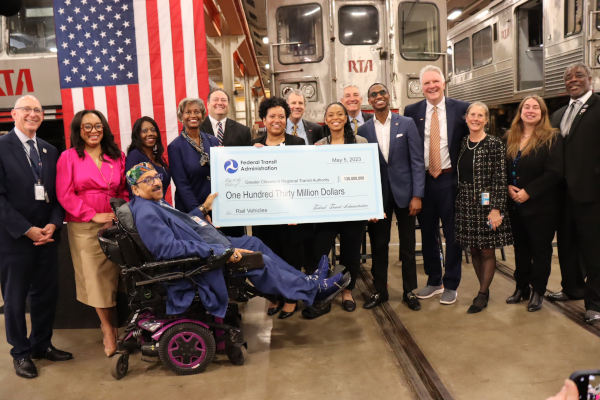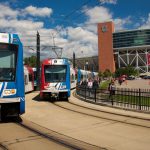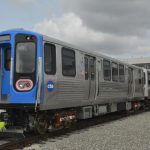 The U.S. Federal Transit Administration (FTA) has selected six projects in six states to replace aging passenger rolling stock with a USD 703 million financing from the Bipartisan Infrastructure Law.
The U.S. Federal Transit Administration (FTA) has selected six projects in six states to replace aging passenger rolling stock with a USD 703 million financing from the Bipartisan Infrastructure Law.
This is the first funding provided from the Rail Vehicle Replacement Programme which was created to improve safety, service, and the customer experience on metro, commuter rail, and light rail systems. The Bipartisan Infrastructure Law will invest a total of USD 1.5 billion in new funding through 2026 for this programme.
In the U.S., the metro and commuter train fleet “is more than 25 years old and this programme focuses on transit agencies that lack the funding they need to address overdue railcar replacements. We are proud to select these projects to improve passenger rail service for riders across the nation,” FTA Administrator Nuria Fernandez said.
“Every day, millions of Americans rely on metro, commuter rail, and light rail to get to work or school, buy groceries, and see loved ones, but many railcars still in service are decades old and in need of replacement. These grants will help bring riders faster, safer, more reliable service on America’s rails,” U.S. Transportation Secretary Pete Buttigieg said.
The selected projects are:
The Chicago Transit Authority (CTA) has received the largest financing worth USD 200 million to acquire up to 300 electric passenger railcars to replace railcars that have been operating since the 1980s. the provided funding “will allow CTA to replace its oldest, most outdated railcars with more modern, safe, and reliable cars, ensuring riders can get to where they’re going on-time and with ease,” Senator Durbin and Representative Quigley said when announced the funding.
The FTA funding allows the agency to begin planning and designing for the future procurement of its next generation of railcars – the 9000-Series. In 2021, CTA has introduces the first 7000-series trains operating the Blue Line, second most heavily traveled rail line in the system, operating between Forest Park and O’Hare International Airport. These new trains are manufactured by CRRC Sifang America under a USD 1.6 billion contract signed in 2016 for the supply of 400 cars. CTA’s rolling stock comprises 1,500 railcars of three different models purchase between 1981 and 2015. The age of railcars impacts their performance, which is why public transit railcars like those used on the CTA have a useful life expectancy of 31 years, with routine maintenance. The procurement of new railcar will improve agency’s state of good repair needs in aging passenger rolling stock which is nearly 40 years.
Ranked second in terms of funding value, the Missouri-Illinois Metropolitan District obtained USD 196.3 million for the procurement of 48 LRVs to replace the existing vehicles that have exceeded or are near the end of their useful life. The 30-year-old MetroLink cars are well maintained and have already exceeded their projected useful lives of 25 years in service. Out of the 31 original MetroLink light rail vehicles, 25 of them are still in service and will continue to be for the next few years until they are replaced by the new light rail vehicles. In the next 4-5 years, the existing fleet is expected to travel 1.8 million miles and it should be replaced. The new vehicles will run on the MetroLink system serving the St. Louis metropolitan region.
The Greater Cleveland Regional Transit Authority (GCRTA) is placed third (also in terms of funding value) and will receive USD 130 million to purchase 60 new light rail and heavy rail vehicles. This grant will be completed by a USD 213 million financing that GCRTA secured from the Rail Car Replacement Programme that has a projected price tag of USD 393 million. The new vehicles will save the GCRTA USD 7 million per year by reducing repair costs and provide more comfortable and reliable service for passengers. The authority will acquire high floor light rail vehicles with doors that allow access from existing heavy rail platforms and street level light rail platforms. Thus, enabling the rail cars to operate across the authority’s entire rail network eliminating the need to run two separate fleets. The new rolling stock will replace the existing one purchased in 1981 and 1982.
The South Florida Regional Transportation Authority (SFRTA) obtained USD 71.7 million to replace 24 rail vehicles representing 32% of its fleet. The funding will support the procurement of new locomotives and passenger cars to replace older vehicles that have exceeded or are near the end of their useful life. USD 179.2 million is the total value of the project that also requires local funding that the agency will supplement with support from the Florida Department of Transportation (FDOT), unrestrictive reserve funds, and additional federal funds. The authority is operating the Tri-Rail commuter rail system in Miami on the 116 km South Florida Rail Corridor and transport 12,500 passengers each day.
Under the Rail Vehicle Replacement Programme, Utah Transit Authority has obtained USD 60 million to purchase 20 LRVs. The new low-floor cars will replace the existing older high-floor TRAX cars operating the 71 km system in Salt Lake Valley.
The Sacramento Regional Transit District in Sacramento (SaCRT), in California, will receive USD 45.1 million to acquire 16 additional light rail vehicles, which will replace older vehicles that have exceeded their useful life. The transit authority will acquire the new low-floor light rail vehicles from Siemens Mobility. In 2020, the manufacturer was awarded a USD 100 million contract for the supply of 20 S700 low-floor light rail vehicles including spare parts and tools. With the purchase of the latest vehicles, Sacramento will benefit 44 new LRVs. This investment will improve the agency’s state of good repair needs and improve service and reliability for the region’s 1.7 million residents.
Under the competitive grant process, FTA has received proposals with funding requests worth USD 3.5 billion. Vehicle Replacement Programme is part of the State of Good Repair Formula Grants Programme which provides capital assistance for maintenance, replacement, and rehabilitation projects for transit systems.
The aging passenger rolling stock contributes to service delays and increased costs and lack newer amenities, such as digital signage and audio tools that improve the riding experience. They may also lack accessibility features, such as direct access into the railcar, for people with reduced mobility or anyone pushing a stroller.
Share on:






